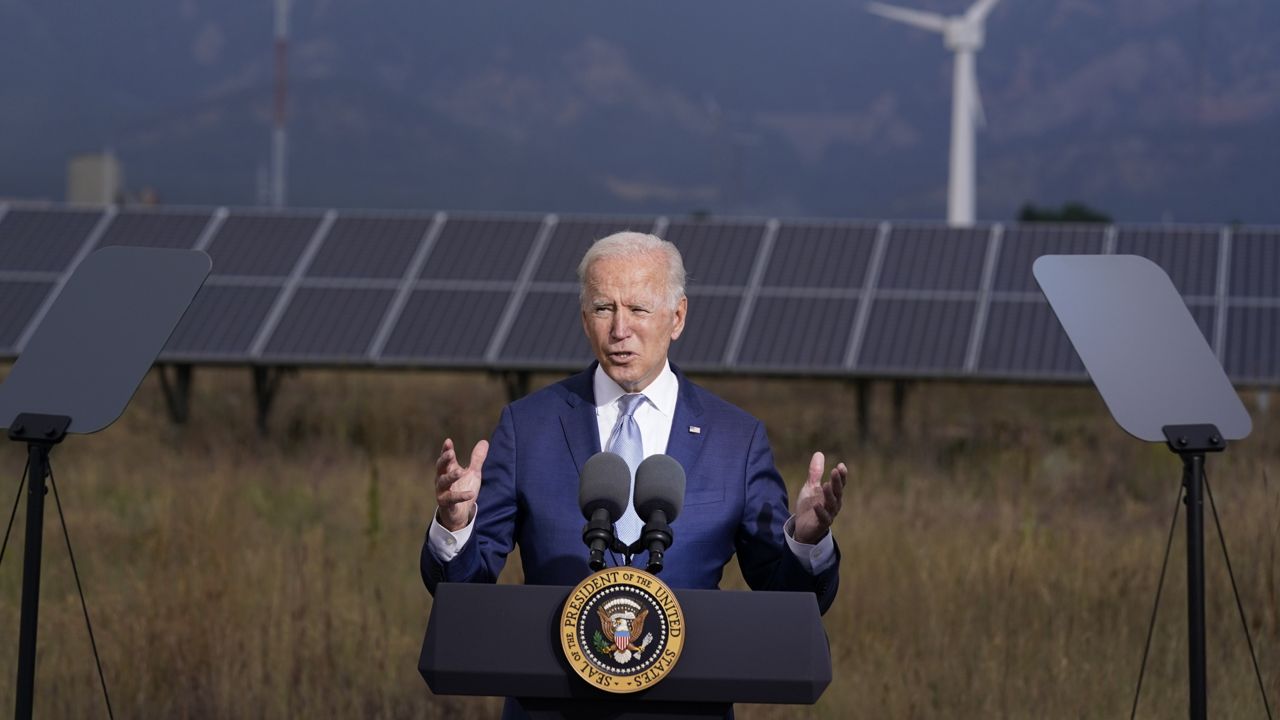President Joe Biden visited Colorado on Tuesday for a tour of the National Renewable Energy Laboratory (NREL) in Arvanda, using the opportunity to pitch his bipartisan infrastructure deal and highlight its green energy components as legislators haggle over the details back in Washington.
What You Need To Know
- President Joe Biden pitched his massive domestic spending package during a visit to a renewable energy lab in Colorado Tuesday
- Biden highlighted how investments in clean energy will help combat climate change, including by funding projects like those at the lab
- Tuesday's trip to the National Renewable Energy Laboratory in Denver capped off the president’s two-day swing to the West
- It also offered him the chance to continue linking the need to pass his spending proposal to the urgent threat posed by climate change
The president was greeted by Gov. Jared Polis and Denver Mayor Michael B. Hancock upon touching down in Colorado.
The group was shown a wind turbine, known as “The Blade,” during their tour of the laboratory, which aims to promote innovations in energy technology across the public, private and governmental sectors. NREL focuses primarily on the areas of renewable power, sustainable transportation, energy efficiency and energy systems integration.
The trip to Colorado capped off the president’s two-day swing to the West, and Biden continued to link the need to pass the spending package to the urgent threat posed by climate change.
“We have to make the investments that are going to slow our contributions to climate change today, not tomorrow,” Biden said in remarks following Tuesday’s tour. “But here's the good news: Something that is caused by humans can be solved by humans.”
Biden spent Monday in Boise, Idaho, and Sacramento, California, receiving briefings on the devastating wildfire season and viewing the damage by the Caldor Fire to communities around Lake Tahoe. Biden on Tuesday noted the impact of climate change has also been felt in Colorado, citing this summer’s deadly mudslides as more reason to invest in green technologies.
Biden’s Build Back Better plan calls for “significant new investments in upgrading research infrastructures laboratories all across the country,” the president said Tuesday, including allocations for wind energy technologies like those being constructed at the National Renewable Energy Laboratory.
During both Monday stops and again on Tuesday, the president made the case that the rebuilding must go beyond simply restoring damaged systems and instead ensure communities can withstand such crises.
“In the end, it's not about red states or blue states. A drought or a fire doesn't see property. It doesn't care or give a damn for which party you belong to,” Biden said. “Disasters aren't going to stop. That's the nature of the climate threat.”
The climate provisions in Biden’s plans include tax incentives for clean energy and electric vehicles, investments to transition the economy away from fossil fuels and toward renewable sources such as wind and solar power, and creation of a civilian climate corps.
Biden has set a goal of eliminating pollution from fossil fuel in the power sector by 2035 and from the U.S. economy overall by 2050.
But the fate of President Biden’s $1 trillion infrastructure package, which passed the Senate in early August, now rests with the U.S. House of Representatives, who return from their summer recess on Sept. 20. House Speaker Nancy Pelosi is hoping to push through that package, as well as a more expansive and expensive $3.5 trillion deal covering non-traditional infrastructure, simultaneously — but infighting between Democrats both in the House and the Senate may delay one or both bills.
The president’s two-day Western swing comes at a critical juncture for a central plank of his legislative agenda. Lawmakers on Capitol Hill are working to assemble details of the infrastructure-plus plan — and how to pay for it, a concern not just for Republicans.
Besides unified Republican opposition in Congress, Biden needs to overcome the skepticism of two key centrist Democrats in the closely divided Senate. Joe Manchin of West Virginia and Kyrsten Sinema of Arizona have expressed concerns about the size of the $3.5 trillion spending package.
Manchin said Sunday that he “cannot support $3.5 trillion,” citing his opposition to a proposed increase in the corporate tax rate from 21% to 28% and vast new social spending envisioned by the president. Manchin also complained about a process he said feels rushed.
In California, Biden appeared to respond to those concerned about the plan’s size, saying the cost “may be” as much as $3.5 trillion and would be spread out over 10 years, a period during which the economy is expected to grow. He also insisted that, when it comes to addressing climate change, “we have to think big.”
"Thinking small is a prescription for disaster,” the president said.
The 100-member Senate is evenly split between Democrats and Republicans. Given solid GOP opposition, Biden’s plan cannot pass the Senate without Manchin's or Sinema’s support.
The White House is trying to turn the corner after a difficult month dominated by a chaotic and violent U.S. withdrawal from Afghanistan and the surging delta COVID-19 variant that have upended what the president had hoped would mark a summer in which the nation was finally freed from the coronavirus.
Biden acknowledged his approval numbers have dipped in recent weeks, but argued his agenda is “overwhelmingly popular” with the public. He said he expects his Republican opponents to attack him instead of debating him on the merits of his spending plan.



